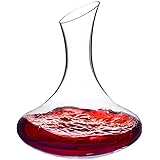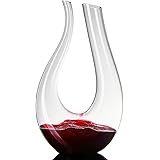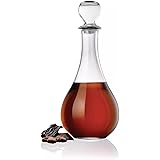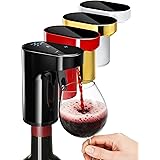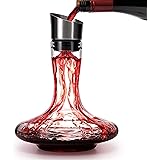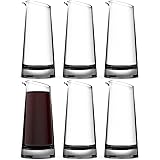The Nuanced Art and Science of Wine Glass Selection: Elevating Your Tasting Experience
Recent sensory studies indicate that the choice of stemware can influence perceived wine quality by as much as 10-25%, a revelation that underscores the profound impact of glass architecture on our sensory experience. While the video above visually introduces various types of wine glasses, the true mastery of wine appreciation extends far beyond simple identification. Understanding the intricate relationship between a wine’s characteristics and its optimal vessel is paramount for any serious oenophile or hospitality professional. This isn’t merely about aesthetics; it’s a sophisticated interplay of design principles engineered to amplify aroma, guide the palate, and enhance the overall expressive qualities of the wine.
Selecting the correct wine glasses is less about snobbery and more about unlocking the full potential of a vintage. Each specific varietal, from a robust Bordeaux to a delicate Burgundy, possesses unique aromatic compounds and structural elements that interact differently with oxygen and the surrounding environment. The specific design of a glass—its bowl shape, rim diameter, and stem length—is carefully calibrated to optimize this interaction. Imagine if you were to serve a meticulously crafted grand cru in a tumbler; the delicate bouquet would dissipate instantly, the acidity would feel out of balance, and the finish would be truncated, leaving a shadow of its intended glory.
Deconstructing the Wine Glass: Anatomy and Purpose
Before diving into specific varietal glasses, a foundational understanding of wine glass anatomy is essential. Every component, from the base to the rim, plays a crucial role in shaping the tasting experience. The base provides stability, while the stem ensures your hand doesn’t warm the wine, preserving its ideal serving temperature. The bowl, the most critical element, is where the wine interacts with air, releasing its aromatic compounds.
The rim, often tapered or flared, directs the flow of wine onto specific areas of the tongue, influencing initial taste perception. Consider the physics involved: a wider bowl allows for greater aeration, crucial for bold reds, while a narrower opening concentrates volatile aromas, ideal for delicate whites. The material itself, typically crystal, contributes to clarity, allowing for visual assessment, and its thinness at the rim provides a seamless transition of liquid to palate, enhancing the mouthfeel.
Mastering Varietal-Specific Wine Glass Types
The vast universe of wine glasses often feels overwhelming, but a systematic approach reveals the logic behind each design. These are not arbitrary distinctions; they are functional adaptations for different wine profiles.
Bordeaux Glass (Cabernet Sauvignon, Merlot, Cabernet Franc)
Characterized by a tall, broad bowl, the Bordeaux glass is engineered for high-tannin, full-bodied red wines. Its generous surface area allows for maximum aeration, which softens the tannins and permits the complex aromas of dark fruit, cedar, and tobacco to unfold beautifully. The height of the bowl ensures that the wine reaches the back of the palate, highlighting its structure and lengthy finish.
Burgundy Glass (Pinot Noir, Nebbiolo, Gamay)
The Burgundy glass stands apart with its exceptionally wide bowl and a narrower rim, designed for more delicate, aromatic red wines. This shape concentrates the subtle, earthy, and floral notes of varietals like Pinot Noir, directing them straight to the nose. The expansive bowl also promotes rapid aeration, crucial for expressing the nuanced fruit and forest floor characteristics of these wines, while the narrower opening funnels these delicate perfumes upwards.
Chardonnay Glass (Oaked Chardonnay, Viognier)
For oaked Chardonnays and other full-bodied white wines, the wider, slightly flared bowl of a Chardonnay glass is ideal. This design allows for sufficient oxidation to release the wine’s richer, creamier textures and complex notes of butter, vanilla, and toasted nuts. The broader opening also helps to temper the acidity, presenting a more harmonious and integrated palate experience.
Sauvignon Blanc Glass (Sauvignon Blanc, Riesling, Grüner Veltliner)
A taller, narrower bowl with a more restricted opening defines the Sauvignon Blanc glass. This shape is specifically crafted to preserve and deliver the crisp, vibrant acidity and aromatic intensity characteristic of unoaked white wines. It directs the wine to the tip and sides of the tongue, emphasizing freshness and fruit, while concentrating the pungent notes of citrus, grass, and mineral that define these varietals.
Champagne Flute/Tulip (Sparkling Wine, Prosecco, Cava)
While flutes are ubiquitous for sparkling wines, the tulip shape offers a subtle yet significant advantage. Both maintain effervescence by minimizing surface area, but the tulip’s slightly wider bowl and tapered rim allow for a better capture and concentration of the delicate brioche, apple, and citrus aromas. The visual spectacle of the persistent bead of bubbles ascending is an integral part of the experience, and these glasses ensure that effect is prolonged.
Dessert Wine Glass (Port, Sauternes, Ice Wine)
Smaller in stature, dessert wine glasses are designed for richer, sweeter wines served in more modest quantities. Their diminutive size concentrates the intense aromas of honey, dried fruit, and caramel, ensuring the richness doesn’t overwhelm the palate. The smaller bowl also helps manage the alcohol content, which is often higher in fortified wines, presenting a more balanced sensory encounter.
Beyond the Varietal: Crystal vs. Glass and Maintenance
The material of your wine glasses significantly impacts both performance and durability. Lead-free crystal, lauded for its refractive qualities, makes wine appear more vibrant and allows for thinner, more delicate rims. Its non-porous surface is also ideal for wine contact, ensuring no unwanted flavors are imparted. Glass, while more robust and often more affordable, tends to be thicker and may not offer the same level of sensory precision.
Proper maintenance ensures the longevity and performance of your stemware. Handwashing with unscented soap and warm water, followed by polishing with a lint-free cloth, prevents water spots and residues that can dull the wine’s appearance or impart off-flavors. Storing glasses rim-up prevents chipping and preserves the delicate edge. Investing in quality wine glasses is an investment in your wine experience, a commitment to savoring every nuance each bottle has to offer.


